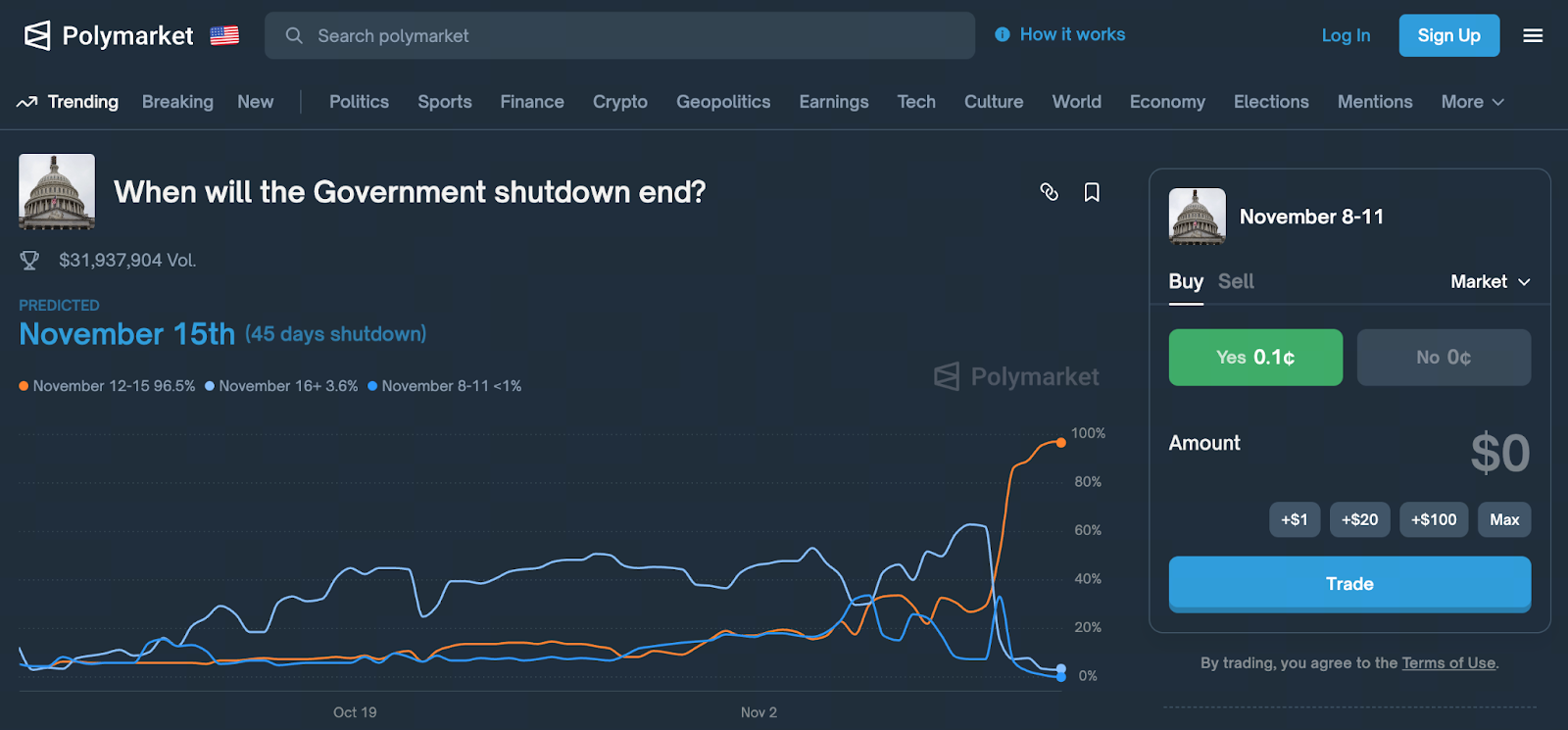What Is Polymarket: Ushering in a New Era of Prediction Market Trading
What Is the Polymarket Prediction Market?

Image: https://polymarket.com/event/when-will-the-government-shutdown-end-545?tid=1762917907077
Launched in 2020, Polymarket is a blockchain-powered prediction market platform. Users can trade on the outcomes of future events, including political elections, economic indicators, cultural and entertainment occurrences, and sports competitions. At its core, Polymarket turns forecasts about the future into tradable probabilities—participants express their views on the likelihood of an outcome by buying or selling event result contracts.
For example, if the platform offers a market on “Will the U.S. government shutdown end before November 13, 2025,” users can purchase contracts for either the “end” or “not end” outcome. The market price reflects the current consensus probability of the event ending. In contrast to traditional forecasting tools like polls or expert opinions, Polymarket represents a market-driven approach to consolidating news, perspectives, and capital in order to derive probabilities.
Latest Major Developments: ICE Investment and U.S. Market Reentry
Recently, Polymarket achieved two major milestones:
- ICE (Intercontinental Exchange, the parent company of the New York Stock Exchange) announced plans for a strategic investment of up to $2 billion in Polymarket, signaling strong institutional endorsement of the prediction market model.
- Polymarket received a green light from the U.S. CFTC to re-enter the U.S. market, marking a pivotal step toward regulatory compliance.
Together, these milestones send three key signals: First, prediction markets are gaining acceptance in mainstream finance; second, Polymarket is positioned to enter the U.S. and capture a larger market share; third, institutions are ready to integrate prediction data with traditional financial instruments. For newcomers, this suggests that Polymarket’s industry is moving toward the mainstream, with the potential to become the next major trend.
Platform Mechanisms: How to Participate and Where Is the Core Value?
From a structural standpoint, Polymarket’s value is highlighted in several areas:
- Event contract trading: Users buy and sell contracts on whether a specific outcome will or will not occur. Higher contract prices indicate a higher perceived probability of that outcome by the market.
- Information aggregation and predictive value: A key benefit of prediction markets is the “wisdom of crowds” effect—collective judgments by many participants cause prices to reflect the most probable outcome, which some researchers regard as faster and more accurate than traditional polls.
- Data and financialization: With ICE’s investment and U.S. regulatory approval, Polymarket’s event-driven data is itself becoming an asset class, with future prospects for integration into broader market data ecosystems and adoption by financial institutions.
- New opportunities: For investors and speculators, these platforms allow both the expression of views and the potential for profit. Note, however, that Polymarket has not yet been widely tokenized—while its native token POLY is frequently discussed, public trading and liquidity remain unclear.
Risk Advisory: Regulatory Challenges and Data Authenticity Issues
Despite promising prospects, newcomers must be aware of the following risks:
- Ongoing regulatory risks: Although Polymarket secured U.S. approval to re-enter the market, it was previously penalized by the CFTC for operating without proper registration. Legal status across various countries and regions remains uncertain.
- Transaction volume authenticity concerns: Recent studies indicate that Polymarket’s transaction volume may be inflated by wash trading, distorting actual activity and market valuation signals.
- Tokenization and liquidity uncertainties: While token issuance is anticipated, there is still no clear or practical path for ordinary users to participate, exit, or determine token value.
- Speculation intertwined with opinion expression: While prediction markets hold theoretical value, they overlap with traditional gambling and speculation. Newcomers should understand that participation involves both expressing views and taking on financial risk—it is not simply a tool for easy profits.
Beginner’s Guide: How to Track and Evaluate Polymarket?
If you are new to Polymarket, consider these practical tips:
- Monitor official announcements: The official Polymarket website, social media, and blog are the primary sources for updates on token issuance, product launches, and progress on U.S. market reentry.
- Watch institutional investment and partnerships: Investments from ICE and partnerships with platforms like PrizePicks are key indicators of credibility.
- Evaluate market activity and trading volume: Analyze transaction volume, contract types, and user participation to identify whether apparent high volume masks low or questionable liquidity.
- Clarify your objectives: If you’re interested in “participating in forecasting,” treat Polymarket as an opinion market tool; if you view it as an investment asset, be diligent with capital management and risk controls.
- Stay informed on regulatory changes: Prediction markets overlap with gambling and derivatives, and regulatory policies may shift abruptly. Keep up to date on the legal status in your jurisdiction.
Summary
As a leader in the prediction market sector, Polymarket reached significant milestones in 2025: major institutional investment, renewed U.S. regulatory approval, and rising market visibility. For users aiming to “profit from opinions” or “trade on future probabilities,” Polymarket offers fresh opportunities. However, regulatory risks, questions around data authenticity, and the trajectory of tokenization remain unresolved. Newcomers should approach the platform with caution and see it as an innovative financial tool—rather than merely a shortcut to profit. If you’d like, I can also provide an overview of Polymarket’s token issuance plans, partner platforms, and competitors (such as Kalshi).
Related Articles

Pi Coin Transaction Guide: How to Transfer to Gate.io

Flare Crypto Explained: What Is Flare Network and Why It Matters in 2025

How to Use a Crypto Whale Tracker: Top Tool Recommendation for 2025 to Follow Whale Moves

What is N2: An AI-Driven Layer 2 Solution

Understand Baby doge coin in one article
